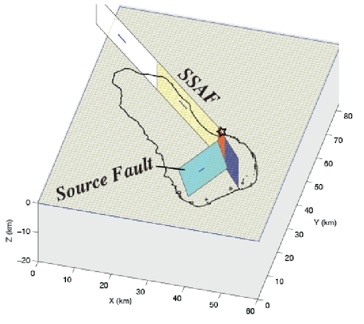Our models include orientations and slip-directions of the source fault (light blue), the Southern San Andreas Fault (SSAF) (yellow) and extensions thereof (red and blue fault planes). We test uncertainties in these model parameters, and other parameters such as friction and fault locations, to assure robustness in project results.

Stress Changes from Earthquakes
Earthquakes can influence the occurrence of other earthquakes. Aftershock sequences exemplify this type of behavior.
A common method to help better understand how one earthquake might trigger another earthquake is to use the Coulomb failure criteria model. In this model, the stress changes induced by one earthquake can be estimated at specific locations.
A commonly employed failure criterion invokes an absolute level of Coulomb stress which when exceeded causes instantaneous rupture. This is consistent with the simple interpretation that a positive or negative value of Coulomb stress can bring a fault closer to or farther from failure, respectively. Put another way, stress changes from one earthquake can advance or delay failure of a subsequent earthquake.
In this work we investigate the causal relationship between earthquakes on the normal faults under the Salton Sea and earthquakes on the southern San Andreas Fault.
For Additional information:
http://quakeinfo.ucsd.edu/~dkilb/
Co-author domain expert: Debi Kilb <dkilb@ucsd.edu>

